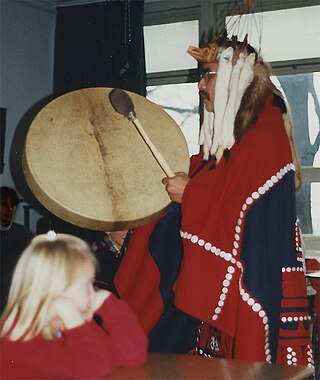
|root=Lingít
"People of the Tides"|person=|people=Tlingit|language=Lingít|country=Tlingit Aaní}} The Tlingit or Lingít are Indigenous peoples of the Pacific Northwest Coast of North America and constitute two of the two-hundred thirty-one federally recognized Tribes of Alaska. Although the majority, about 14,000 people, are Alaska Natives, there is a small minority, 2,110, who are Canadian First Nations.

Totem poles are monumental carvings found in western Canada and the northwestern United States. They are a type of Northwest Coast art, consisting of poles, posts or pillars, carved with symbols or figures. They are usually made from large trees, mostly western red cedar, by First Nations and Indigenous peoples of the Pacific Northwest Coast including northern Northwest Coast Haida, Tlingit, and Tsimshian communities in Southeast Alaska and British Columbia, Kwakwaka'wakw and Nuu-chah-nulth communities in southern British Columbia, and the Coast Salish communities in Washington and British Columbia.

The Tsimshian are an Indigenous people of the Pacific Northwest Coast of North America. Their communities are mostly in coastal British Columbia in Terrace and Prince Rupert, and Metlakatla, Alaska on Annette Island, the only reservation in Alaska.

Sealaska Corporation is one of thirteen Alaska Native Regional Corporations created under the Alaska Native Claims Settlement Act of 1971 (ANCSA) in settlement of aboriginal land claims. Headquartered in Juneau, Alaska, Sealaska is a for-profit corporation with more than 23,000 Alaska Native shareholders primarily of Tlingit, Haida, and Tsimshian descent.

Nora Marks Keixwnéi Dauenhauer was a Tlingit poet, short-story writer, and Tlingit language scholar from Alaska. She won an American Book Award for Russians in Tlingit America: The Battles of Sitka, 1802 And 1804. Nora was Alaska State Writer Laureate from 2012 - 2014.

Northwest Coast art is the term commonly applied to a style of art created primarily by artists from Tlingit, Haida, Heiltsuk, Nuxalk, Tsimshian, Kwakwaka'wakw, Nuu-chah-nulth and other First Nations and Native American tribes of the Northwest Coast of North America, from pre-European-contact times up to the present.

David A. Boxley is an American artist from the Tsimshian tribe in Alaska, most known for his prolific creation of Totem Poles and other Tsimshian artworks.

Delores E. Churchill is a Native American artist of Haida descent. She is a weaver of baskets, hats, robes, and other regalia, as well as leading revitalization efforts for Haida, her native language.

Jennie Thlunaut was a Tlingit artist, who is credited with keeping the art of Chilkat weaving alive and was one of the most celebrated Northwest Coastal master weavers of the 20th century.

Nathan Jackson is an Alaska Native artist. He is among the most important living Tlingit artists and the most important Alaskan artists. He is best known for his totem poles, but works in a variety of media.
Walter Alexander Soboleff was a Tlingit scholar, elder and religious leader. Soboleff was the first Native Alaskan to become an ordained Presbyterian minister.

The Totem Heritage Center is a historical and cultural museum founded in 1976 and located in Ketchikan, Alaska. The center is operated by the city of Ketchikan.

Nicholas Galanin is a Sitka Tribe of Alaska multi-disciplinary artist and musician of Tlingit and Unangax̂ descent. His work often explores a dialogue of change and identity between Native and non-Native communities.
Justin V. Parish is an American politician who served for one term in the Alaska House of Representatives. His family includes Tlingit people. In 2017, "Representative Justin Parish, a first-time legislator, introduced himself in Tlingit and acknowledged his own Native heritage. His paternal grandmother is a member of the Dog Salmon clan."

Rosita Kaaháni Worl is an American anthropologist and Alaska Native cultural, business and political leader. She is president of the Sealaska Heritage Institute, a Juneau-based nonprofit organization that preserves and advances the Tlingit, Haida and Tsimshian Native cultures of Southeast Alaska, and has held that position since 1997. She also served on the board of directors of the Sealaska regional Native corporation for 30 years, beginning in 1987, including as board vice president. The corporation, with more than 22,000 shareholders, founded the heritage institute and provides substantial funding.
Jackson Polys is a Tlingit Native visual artist and filmmaker whose work is based between Alaska and New York. His work examines the constraints and potential in the desire for Indigenous advancement, while challenging existing gazes onto traditional Native culture. Polys is well known for his films, institutional critique, and carved sculptures incorporating materials such as abalone, glass, liquids, resins, silicone, as well as the ready-made.
Lily Hope is an Alaska Native artist, designer, teacher, weaver, Financial Freedom planner, and community facilitator. She is primarily known for her skills at weaving customary Northwest Coast ceremonial regalia such as Chilkat robes and ensembles. She owns a public-facing studio in Juneau, called Wooshkindein Da.àat: Lily Hope Weaver Studio which opened downtown in 2022. Lily Hope is a mother of five children, and works six days a week.

Ravenstail weaving, also known as Raven's Tail weaving, is a traditional form of geometric weaving-style practiced by Northwest Coast peoples.

Vicki Lee Soboleff is a Haida and Tlingit artist, dancer, and teacher who specializes in Haida basketry. She was awarded the Margaret Nick Cooke Award in 2016 from the Alaska State Council on the Arts and the Alaska Humanities Forum for her work with Alaska Native dance.
Kelsey Mata is an American illustrator and artist. A member of the Tlingit tribe, she is known for her work in children's picture books and digital art that portray Indigenous characters and ways of life.



















